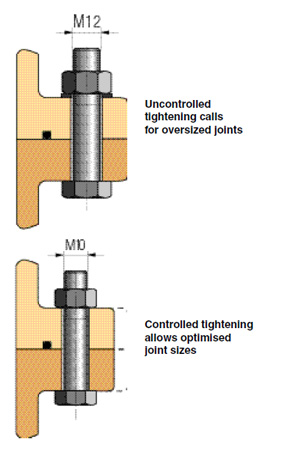Bolt-tightening Methods
Without a doubt, bolted assemblies are the most commonly used joints in mechanics. These types of assemblies employ two basic elements:
- on the one hand, some kind of threaded component:
– screws and nuts,
– studs with nuts on one end,
– studs with nuts on both ends. These components are sometimes used with diff e r e n t kinds of washers (Fig.1a below). - on the other hand, some means for tightening. These types of tightening means are the subject of this Handbook.
In this document the word “bolt” will be used in a generic sense to cover all three of the types of screwing components mentioned above.
Although bolted assemblies at first appear very simple, they cause several problems for design engineers, assemblers, and maintenance departments.
Rough-dimensioning methods are too often used at the design stage, leading to substantial oversizing
of all the components of the assembly, which does not ensure assembly safety, quite the contrary.
In reality, the design of a bolted assembly requires a methodical and rigorous approach, since mistakes can lead to failures with often costly and sometimes disastrous consequences.
Many surveys show that failures of bolted assemblies are mainly due to the fact that they were not properly designed (analysis, drawing, calculation, choice of components) or implemented (tightening method, tooling, checking).
The surveys also show that among the possible causes of assembly failure (overloading, improper design, manufacturing defects etc.) the most frequent is poor assembly. Under tightening, overtightening and irregular tightening alone cause 30% of all assembly failures. Furthermore, in addition, 45% of all fatigue incidents are due to poor assembly



Correct tightening of a bolt means making the best use of the bolt’s elastic properties.
To work well, a bolt must behave just like a spring.
In operation, the tightening process exerts an axial pre-load tension on the bolt. This tension load is of course equal and opposite to the compression force applied on the assembled components. It can be referred to as the “tightening load” or “tension load”.
Depending on the application, the purpose of the tightening load is multiple:
– ensure the rigidity of the whole assembly and make it capable of supporting external loads due to traction, compression, bending moments and shear;
– prevent leakage at seals;
– avoid shear stresses on the bolts;
– resist spontaneous loosening effects ; – reduce the influence of dynamic loads on the fatigue life of the bolts
Furthermore, all components (bolts and assembly parts) must perform these tasks while remaining below the yield point of their respective materials.
Bolt-tightening is optimal when the bolt is properly tightened: not too much, not too little! A bolt can fail just as often – and even more so – when it is not tightened enough, as when it is over-tightened.
l over the tightening conditions – from the outset of the design stage – ensures the best use of the bolt ’s
Controlling bolted assemblies
It is fundamental to control the level of the tightening load, as well as the accuracy of the tightening value, to ensure that required performance of the bolted assembly will be achieved.
Complete control over the tightening conditions – from the outset of the design stage – ensures the best use of the bolt ’s mechanical properties of bolts,

Mechanical properties of bolts
Bolts are most often made of steel. Like most metals, steel is elastic, at least as long as the strain (elongation) does not exceed the “elastic limit” beyond which permanent deformation occurs. Within the “elastic limit”, a metal part such as a bolt follows Hooke’s law, that is to say that the strain (elongation) is proportional to the stress (load), as shown on the graph opposite.
Any tightening method must ensure that the stress in the bolt never exceeds point “A” (the elastic limit or “yield point”), both during the tightening operation and when the assembly is later exposed to efforts during operation.

When discussing structural mechanics, the following properties of materials will be considered:


